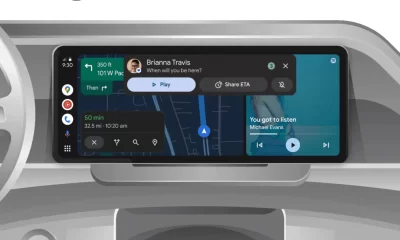Google rollsout Gemini Live to free users, Chrome introduces one-tap unsubscribe, and Google Photos improves clutter management

Top 3 Key Points:
- Gemini Live Available to Free Users: Google extends Gemini Live for free Android users, allowing conversational AI interactions.
- Chrome Enhances Security with One-Tap Unsubscribe: Google Chrome adds a feature to easily unsubscribe from web notifications and revokes permissions from unwanted sites.
- Google Photos Boosts Clutter Management: New options to control backed-up content and third-party app images are coming to Google Photos.
Google is expanding its popular Gemini Live feature, initially available to Advanced subscribers, to all free Android users. Gemini Live enables users to interact in real time with an AI, allowing fluid conversations where users can interrupt and add new information during a session. You can access it via a circular waveform icon at the bottom-right corner of the Gemini interface. Once activated, Gemini Live runs in the background, and users can stop the session by either tapping a button or saying “Stop.”
Although the feature is still missing Gemini Extensions that will let it access apps like Gmail and YouTube Music, these capabilities are expected soon. Gemini Live also introduces 10 new voices, each with different tones and characteristics, allowing users to personalize their experience further.
Currently, Gemini Live is available in English on Android devices, with more languages on the way.
Chrome’s New Notification Controls
Google Chrome is also improving user safety and control with a new one-tap “Unsubscribe” button for web notifications. Initially available on Pixel devices, this feature is rolling out to more Android devices soon. Chrome will automatically run Safety Check in the background, checking for compromised passwords, and outdated versions, and ensuring Safe Browsing is turned on. Chrome will also take steps to revoke permissions from sites no longer in use or flagged as deceptive.
Safety Check’s one-time permissions for camera and microphone access will be revoked after leaving a website, ensuring better privacy. On desktop, the tool will also flag risky Chrome Extensions and offer quick removal options. Chrome’s proactive security approach has already reduced notification volume by 30% on supported devices, and it is expected to have a wider impact as more users adopt the feature.
Google Messages Shrinks Gemini Button
Meanwhile, in Google Messages, the floating action button (FAB) for Gemini has been scaled back to its original size. After being enlarged last month, the button is now smaller, providing a more subtle experience without covering significant screen space. The more compact design makes it less obtrusive, which could encourage more users to keep it enabled.
Google Photos Enhances Clutter Management
Google Photos, a favorite app for managing photos and videos, is working on improved clutter management. Users who back up content from third-party apps will soon have more control over how these images appear in their feeds. An option to show only backed-up images from third-party apps is under development, giving users a cleaner, more organized view of their photos.
Additionally, Google Photos will soon show how many photos in each device folder still need to be backed up, helping users manage their storage more effectively. Although this feature is still in development, it promises to offer more control over cloud backups.
These improvements are expected to make Google Photos even more efficient for managing device folders and third-party app content, though the feature isn’t live just yet.
Google Pixel Watch 4: First look at its design
Google’s upcoming Pixel Watch 4 is creating buzz with its sleek and modern design, revealed through recent leaks. The smartwatch keeps the signature circular shape that fans love, but it brings some fresh updates that make it stand out.
The Pixel Watch 4 has a smooth, rounded body with a shiny finish, giving it a stylish and polished look. Its digital crown, a key feature for easy navigation, is slightly larger this time, making it simpler to use. The watch also seems to have a thinner frame, which could mean a bigger screen for viewing notifications, apps, or fitness stats.
Leaked images show the watch in multiple colors, including a classic black, a soft silver, and a bold new shade that might catch attention. The straps look comfy and interchangeable, so users can switch up their style easily. Whether you’re dressing up or keeping it casual, the Pixel Watch 4 seems ready to match any vibe.
On the tech side, rumors suggest the Pixel Watch 4 will run on Google’s latest Wear OS, offering smoother performance and better battery life. It’s expected to pack advanced health features like heart rate tracking, sleep monitoring, and possibly even stress detection. These tools aim to help users stay on top of their wellness goals.
The leaked video gives a 360-degree view of the watch, highlighting its slim design and vibrant display. While Google hasn’t shared an official release date yet, the Pixel Watch 4 is shaping up to be a strong contender in the smartwatch world. Fans are excited to see how it will blend style and smart features when it finally hits the market.
Android
Google Pixel and Android teams face job cuts

Google has made some tough calls recently, letting go of employees working on its Pixel phones, Android system, and Fitbit devices. The layoffs, which happened earlier this week, affected a small number of staff members, including some managers. The company hasn’t shared exact details about how many people lost their jobs or which teams were hit hardest, but the changes are part of a bigger plan to work smarter and focus on key projects.
Even with these cuts, Google says it’s still committed to building great Pixel phones and improving Android. The company believes these changes will help its teams work better together and create products that users love. Some of the employees who were let go might get a chance to apply for other roles within Google, but it’s not guaranteed that everyone will stay.
This isn’t the first time Google has trimmed its workforce. Last year, it cut jobs in other areas, like its Waze mapping app, as part of efforts to save money and streamline operations. Despite the layoffs, Google insists its plans for Pixel, Android, and Fitbit remain strong. The company is pushing forward with new ideas and products to compete in the crowded tech world.
The news has raised questions about what’s next for Google’s hardware and software teams. Fans of Pixel phones and Android are hopeful the changes won’t slow down the company’s progress. For now, Google is staying focused on delivering updates and new devices while navigating these internal shifts. Only time will tell how these changes shape the future of its products.
Google Keep’s widget gets a fresh look and Google Messages might tone down colors

Google Keep’s widget on Android is getting a makeover to make it more user-friendly. The updated design, now rolling out, uses space better and looks cleaner. The Quick Capture widget, shaped like a clover, now fills its area completely, making it easier to tap.
When resized, it adjusts smartly: a small 2×1 size turns into a single button, while a larger 2×2 size shows note options clearly. The 3×1 version is bigger and simpler to use. This change matches Google’s style for other apps, like Drive, and is part of Keep’s latest update. You might need to reinstall the widget to see it.
Meanwhile, Google Messages could soon look less colorful. The app has been using bright Material You themes, which pull colors from your phone’s wallpaper. But some users find them too bold. A new test shows Messages might switch to simpler, more neutral tones. This would make chats easier on the eyes, especially for those who prefer a clean look. The change isn’t final yet—it’s just being tried out in beta versions. If it goes through, it could make the app feel calmer and more focused.
Both updates show Google tweaking its apps to balance style and function. Keep’s widget aims to make note-taking smoother, while Messages might offer a less distracting chat experience. These changes are gradual, so not everyone will see them right away. Keep an eye out for updates to try them yourself!
-

 Apps1 year ago
Apps1 year agoGboard Proofread feature will support selected text
-

 News1 year ago
News1 year agoSamsung USA crafting One UI 6.1.1
-

 News1 year ago
News1 year agoBreaking: Samsung Galaxy S22 may get Galaxy AI features
-

 News1 year ago
News1 year agoSamsung Galaxy S23 Ultra with One UI 6.1 and all S24 AI features revealed
-

 News1 year ago
News1 year agoOne UI 6.1 Auracast (Bluetooth LE Audio) feature coming to many Samsung phones
-

 News1 year ago
News1 year agoSatellite SOS feature coming to Google Pixel phones, evidence leaked
-

 Apps11 months ago
Apps11 months agoGoogle’s fancy new Weather app is finally available for more Android phones
-

 News1 year ago
News1 year agoGoogle Pixel evolves as Europe’s third best selling flagship








